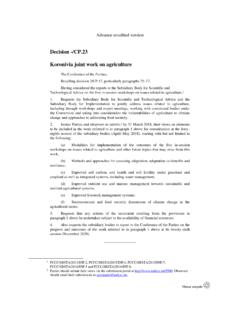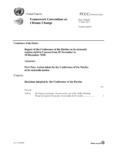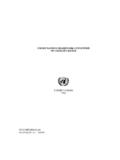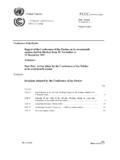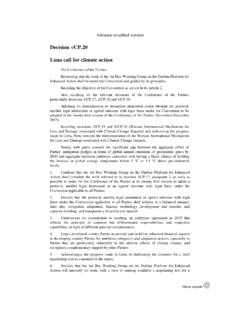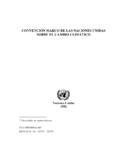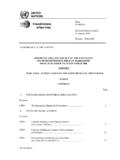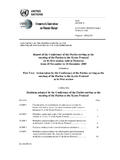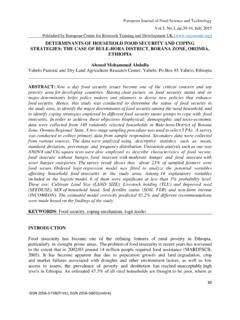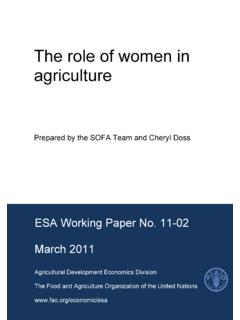Transcription of CLIMATE CHANGE IMPACT ON AGRICULTURE AND FOOD …
1 1 CLIMATE CHANGE IMPACT ON AGRICULTURE AND food security Viliami T. Fakava FAO Sub regional Office for Pacific IslandsApia, Samoa Regional Training Workshop on Adaptation for the Pacific Least Developed Countries, 28 September 3 October 2012, Funafuti, Tuvalu2 PRESENTATION OVERVIEW Challenge for AGRICULTURE & food security Significance of AGRICULTURE Impacts of CLIMATE CHANGE on AGRICULTURE CLIMATE CHANGE Adaptations FAO Assistance to CLIMATE ChangeRegional Training Workshop on Adaptation for the Pacific Least Developed Countries, 28 September 3 October 2012, Funafuti, Tuvalu3 Global Challenges for AGRICULTURE & food SecurityGlobal Challenges for AGRICULTURE & food SecurityPopulationClimate ChangeFood demandGlobal Trade Pests & diseasesBiodiversity Resources Regional Training Workshop on Adaptation for the Pacific Least Developed Countries, 28 September 3 October 2012, Funafuti, Tuvalu4 The Pacific Island Countries (PICs) have limited resources (land & water) , biosecurity capacities and more vulnerable to the;- IMPACT of CLIMATE CHANGE -globalisation of trade and market uncertainties, -and the spread of introduced weeds, pests and diseases, and invasive species.
2 Regional Training Workshop on Adaptation for the Pacific Least Developed Countries, 28 September 3 October 2012, Funafuti, TuvaluCHALLENGE FOR PACIFIC ISLANDS5 The Pacific Islands are the most vulnerable to CLIMATE CHANGE due to its geographical remoteness and size. Scientists have projected that by 2100 Pacific Islands would experience:- sea-level rise by about ,- surface air-temperature to increase by C,- rainfall could either rise or fall with predicted impacts of to ,- El Nino conditions possibly more frequently, - tropical cyclones becoming more intense,- saline intrusion into freshwater lenses,- increased floodingRegional Training Workshop on Adaptation for the Pacific Least Developed Countries, 28 September 3 October 2012, Funafuti, Tuvalu6 AGRICULTURE IN THE PACIFIC ISLANDSA griculture is vital and central to PIC s economy with contribution of.
3 -Major food source-Raw materials supply for manufacturing- Source of income -Contribution to GDP-Foreign Exchange-EmploymentRegional Training Workshop on Adaptation for the Pacific Least Developed Countries, 28 September 3 October 2012, Funafuti, Tuvalu7 AGRICULTURE in the LDC countriesRegional Training Workshop on Adaptation for the Pacific Least Developed Countries, 28 September 3 October 2012, Funafuti, TuvaluCountryLand Area(km )Sea Area( 000 km )To t a lPopulation(,000)AgriculturalContributio nto GDP (%)Kiribati7263 5508317 Samoa2 93412017714 Solomon 7851 34043240 Vanuatu12 18968017720 Tuvalu2675710248 What are the Impacts of CLIMATE Changes on AGRICULTURE & food security ?
4 - AGRICULTURE production will be affected by increasing temperatures, changing rainfall patterns, and more frequent and intense extreme weather events. - These will have direct effects on crop growth and their need for water, as well as soil fertility, water supply for irrigation, and prevalence of pests and diseases. In terms of livestock, CLIMATE CHANGE also will affect the quality and amount of feed supply and Key Challenge for PICs9 CLIMATE hazards will affect AGRICULTURE through;- heat stress on plants,- changes in soil moisture and Temperature- loss of soil fertility through erosion of top soil, - less water available for crop production- changes in height of water table- salinization of freshwater aquifer, -and loss of land through sea level rise.
5 The consequences of such impacts are likely to be particularly severe in the atoll islands (Tuvalu & Kiribati) because AGRICULTURE is already under stress due to poor soil, limited available land, and water Cyclones and StormsCyclones are a significant cause of lost agricultural production. For example, Cyclone Ami caused over US$35 million in lost crops in Fiji in 2003. Cyclones Ofa and Val, which hit Samoa in 1990/91, causing losses of US$440 million which was greater than the country s average annual Severe Drought Severe drought presents problems for AGRICULTURE everywhere in the Pacific region. Pacific AGRICULTURE more rainfed and lack of irrigation.
6 Tuvalu had experienced that in and water causing soil erosionPoor road construction induce soil erosion after heavy rain with top soil being drained off to coastal or flood damages to key infrastructureIncreased risk of flooding in river catchments also threatens food production. Heavy flooding of the Cyclone or flood damages to key infrastructureDamages to roads, bridges, storage, water supply and market infrastructures can upset the effective Pest and disease outbreaksChanges in rainfall patterns, temperature and wind direction could result in the establishment and emergence of new pests and diseases threatening AGRICULTURE & food security .
7 Samoa s experience with outbreak of Taro Leaf Blight in 1993 - 95% reduction in taro production Taken 16 years to breeding for resistant varieties and resume recognizes that these two challenges must beaddressed together through;1. Sustainable management of natural resources2. CLIMATE CHANGE adaptation,a must for the agricultural sectors to achieve foodand nutrition Key Strategies17 In 2009, the World Summit on food security recognized the challenges CLIMATE CHANGE presents to food security and request support to adaptation and mitigation efforts in AGRICULTURE , as well as efforts to increase the resilience to CLIMATE CHANGE , with particular attention to small agricultural producers and vulnerable populations.
8 FAO developed a Framework Programme on CLIMATE CHANGE Adaptation, called FAO-Adapt is a concrete tool towards achieving these goals. FAO-Adapt will help enhance this support by mainstreaming CLIMATE CHANGE adaptation into all FAO dlttiiti ttil ildlblFAO-ADAPT - FAO S Framework Programme on CLIMATE CHANGE Adaptation18 FAO-ADAPT - FAO S Framework Programme on CLIMATE CHANGE Adaptation191. Supporting IMPACT assessment and adaptation with data and has developed a wide range of innovative, user friendly data systems and tool for assessing CLIMATE IMPACT and vulnerability, and for planning adaptation Strengthen institutions, and assist countries in implementing adaptation assists member countries in integrating CLIMATE CHANGE into national AGRICULTURE , forestry, and fisheries sector policies, and food security programs.
9 Support countries in developing and implementing priorities and PRIORITY ADAPTATION THEMES & ACTIONS203. Sustainable and CLIMATE -smart management of land, water and biodiversityFAO advocates for CLIMATE -smart AGRICULTURE which sustainably increases productivity, resilience (adaptation), reduces/removes GHGs (mitigation), and enhances achievement of national food security and development Technologies, practices and processes for adaptationFAO supports the development and dissemination of improve technologies, practices and processes related to AGRICULTURE , forestry, fisheries to increase resilience of the production systems and improve Disaster risk managementFAO supports the strengthening capacities on disaster risk management, improve local practices for risk reduction and enhanced emergency response and rehabilitation farming systems -low input shifting AGRICULTURE systems, agro forestry base, mixed cropping.
10 Extended fallow periods, and natural rain fed irrigation. Modern conventional farming systems - high-input production systems, monocropping, intensive land cultivation, increasing use of agrochemicals. Eg squash in Tonga, sugar cane, papaya, taro, ginger, and taro in AGRICULTURE PRODUCTION PRACTICES & TECHNOLOGIES22 In the Pacific effective CLIMATE -smart practices already exist, such as the many forms of agroforestry, multi cropping, minimal use of agrochemical, with inclusion of high levels of cultivar biodiversity - already provide a basis to address potential CLIMATE CHANGE impacts. To help countries in the region build more CLIMATE resilient AGRICULTURE systems FAO has developed a food security Toolkit, designed specifically for Pacific Island Countries which provides recommendations on adaptation steps that are designed to promote crop diversification and maintain ecosystem services, whilst minimizing adverse environmental farming systems Improved sustainable farming practices that have been developed and successful in Pacific and Asian developing countries.
